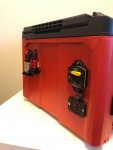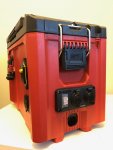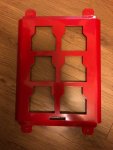Martinjmpr
Wiffleball Batter
This is really a companion to my other thread where I installed a Renogy 20A DC-DC battery charger in my 2018 F-150.

 www.expeditionportal.com
www.expeditionportal.com
That thread focused on the Renogy charger and how I got it installed and working, but I realized I kind of short-changed the description of what it was that the Renogy charger was actually powering. So I thought I'd do this writeup of my 12v "power box" for those who are thinking of coming up with something similar.
Background:
So the idea behind this was that I needed something that would take the place of the "house battery" that I had in my '04 Suburban. The Suburban had a dedicated spot for a 2nd battery and a relatively simple electrical system, so adding a 2nd battery to power the refrigerator (Indel-B TB-41 40 liter fridge/freezer) was a pretty straightforward process.
When I replaced the Suburban with a 2018 F-150 I had to reckon with two complications: First, there simply was no space to put a 2nd battery in the engine compartment without relocating other components, and Second that the modern F-150 with its battery management system and "smart alternator" might not work with a dual battery (or might not work correctly.) Given the complicated nature of modern electronics, I decided not to monkey with it and go with "plan B" which was to have a removable, rechargeable 12v power source for the fridge.
Construction:
I started with a Minn-Kota 12v Trolling Motor enclosure. This is basically a cheap battery box with a few modifications: It has a set of terminals that connect to the battery and go to terminal posts on the OUTSIDE of the box. These terminals in turn have wing nut cap screws to protect the terminals from grounding (they are also protected by a circuit breaker.) Additionally, it has a pair of 12v cigarette lighter type outlets (protected by a second, 10A circuit breaker) and a rudimentary "Red/Amber/Green" "battery life monitor" aka volt meter. Total cost was around $60 and available from Amazon (NOTE: I'll post the amazon links to all products at the end of this post.)

The battery I chose was purchased at Costco, a simple Group 27 deep cycle Marine/RV FLA (wet) battery, 90AH. I may eventually upgrade to an AGM, or I may not. Biggest drawback is weight, probably 75lbs!
Although the battery box could have worked "as-is", I added a few things right off the bat. The first thing was a Battery Tender SAE connection for charging. I keep my motorcycles on a battery tender (trickle charger) at home and since I had just sold a motorcycle, I had an extra tender, so I put the lead on and hung it out one of the side cable slots on the battery box. This way I can keep the battery plugged into a trickle charger (.75a 120vAC) at home when not in use. The .75a charger will not over charge it and will make sure I always start off with a fully charged battery.
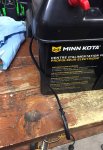
The next thing I added was an LED Voltmeter and dual USB charging port. I actually had purchased this to put into the Suburban and never got around to it, so it was sitting on my bench. The Minn-Kota enclosure did not come with a USB port and I didn't like the "Red/Amber/Green" volt meter, I preferred an actual voltage reading, and this filled both requirements. It's wired directly to the battery with ring terminals.
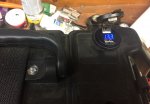
The next problem revealed itself the first time I tried to use it to run the refrigerator. Theoretically, the 12v "universal" power ports on the side of the Trolling Motor box should work for the 12v fridge right? Well, yes, "theoretically" they do - the problem is, they won't stay connected! The spring "plunger" in the middle of the fridge plug keeps pushing against the inside of the enclosure and disengaging it. I noticed this the first time on a camping trip where I couldn't figure out why my fridge was not being powered and I realized that if I wasn't actively pushing the plug in, it would not stay engaged.
Years ago I had purchased a simple 12v power plug that was attached to two alligator clips for direct attachment to a battery. I was relieved to find out that my 12v power plug WOULD stay plugged in to this socket. So I cut off the alligator clips and replaced them with ring terminals. Ring terminals then went onto the external power posts on the Minn-Kota box. Not pretty, but it works:
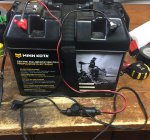
Now at this point, someone is sure to say "why not just get rid of the crappy 12v cig lighter plug altogether and put the ring terminals on the fridge power cord?" Actually, I plan on doing that soon, although for right now this works (I do have a second power cord in case, for some reason, I need a 12v cig lighter plug for the fridge.)
The final modification was getting power TO the box to keep it charged. I used a HYCLAT Anderson-type connector with some 10g wire I had laying around to connect the DC-DC charger to the battery box. 10AWG should be more than adequate to get the power from the Renogy charger to the battery box (roughly 2.5'/30" max.) Wired to ring terminals on the battery through the cable tunnel on the opposite side of the SAE connector:

Results:
After almost a year and 6 camping trips with this system, I have to say it has met or exceeded all of my expectations. Never has the battery voltage dropped low enough to cause the fridge to shut off. The Renogy charger seems to keep the battery well charged and with 90AH on board, I don't need to worry about running it down.
Most recent camping trip was 4 days. We actually had an electrical hookup at this campground and normally when we have electrical hookups, I just run an extension cord to the fridge to run it on 120vAC while we are parked. But in this case, I really wanted to see how well the battery box and DC-DC charger would work and it worked very well. Even though it was hot (over 85 degrees every day) and I normally kept the windows on the truck rolled up (I'd estimate daytime high temps inside the truck were over 100) the fridge stayed cold and battery voltage never dropped below 12.3. I did a little driving each day - maybe an hour the first day and a half hour the second day - but that seemed to be more than enough to keep the battery "topped off."
My guess is that without running the truck, I can power the fridge just from the power box for at least 2 full days depending on outside temperature. If I drive the truck at least an hour each day, there is no practical limit as to how long it will run (or as I like to say it "I'll run out of food to keep cold before I run out of power for the fridge.")
Would I do it again? To be honest, I'm not sure. By the time you add up all the components I bought (including the DC-DC charger and all the wiring necessary for that) I'm in for about $450, and that does NOT include my time (most difficult step was figuring out how to get power to the DC-DC charger. I eventually settled for running a pair of 8g wires directly to the battery through a hole in the floor of the cab, which I had hoped I wouldn't have to do.)
Nowadays, for $450 you can get a Lithium-Ion "power pack" that will charge off of either 120vAC or a 12v DC cig lighter, and even includes an inverter (which mine does not.) Would that be a "better" solution? Only time will tell. Certainly it would be a LIGHTER solution than my ~80lb monstrosity (though in all fairness, I could lighten mine up considerably with a Lithium battery, too.)
Those who are very particular about safety may also note that I did not put a fuse in-line between the Anderson connector and the battery. Should I have done so? Probably, but this entire run of cable from the battery to the DC-DC charger is only about 2 1/2 feet long, on double insulated wire (i.e. insulated and then surrounded by wire loom) and stays inside the truck at all times. I suppose if I wanted to be "Mr. Safety" I could splice a 30A fuse in between the Anderson connector and the battery but I don't really think it's necessary.
Anyway, that's my writeup. Hit me with any questions you have.
For those interested, here are the links:
Minn-Kota trolling motor enclosure:
https://www.amazon.com/MinnKota-Tro...+trolling+motor+battery&qid=1595271028&sr=8-5
Battery tender SAE harness:
12v dual USB port and volt meter universal cig lighter socket:
12v Universal Power Outlet with Alligator clips:
HYCLAT 6 -10 gauge Anderson type connector:

Installing Renogy DC-DC charger in 2018 F-150
Posting this for anyone who might be interested in doing something similar. Background: The idea behind this came from my previous vehicle, a 2004 Suburban. When we camp we use an Indel-B TB 41 refrigerator and in the past we've had "issues" with it discharging the battery enough to cause...
 www.expeditionportal.com
www.expeditionportal.com
That thread focused on the Renogy charger and how I got it installed and working, but I realized I kind of short-changed the description of what it was that the Renogy charger was actually powering. So I thought I'd do this writeup of my 12v "power box" for those who are thinking of coming up with something similar.
Background:
So the idea behind this was that I needed something that would take the place of the "house battery" that I had in my '04 Suburban. The Suburban had a dedicated spot for a 2nd battery and a relatively simple electrical system, so adding a 2nd battery to power the refrigerator (Indel-B TB-41 40 liter fridge/freezer) was a pretty straightforward process.
When I replaced the Suburban with a 2018 F-150 I had to reckon with two complications: First, there simply was no space to put a 2nd battery in the engine compartment without relocating other components, and Second that the modern F-150 with its battery management system and "smart alternator" might not work with a dual battery (or might not work correctly.) Given the complicated nature of modern electronics, I decided not to monkey with it and go with "plan B" which was to have a removable, rechargeable 12v power source for the fridge.
Construction:
I started with a Minn-Kota 12v Trolling Motor enclosure. This is basically a cheap battery box with a few modifications: It has a set of terminals that connect to the battery and go to terminal posts on the OUTSIDE of the box. These terminals in turn have wing nut cap screws to protect the terminals from grounding (they are also protected by a circuit breaker.) Additionally, it has a pair of 12v cigarette lighter type outlets (protected by a second, 10A circuit breaker) and a rudimentary "Red/Amber/Green" "battery life monitor" aka volt meter. Total cost was around $60 and available from Amazon (NOTE: I'll post the amazon links to all products at the end of this post.)

The battery I chose was purchased at Costco, a simple Group 27 deep cycle Marine/RV FLA (wet) battery, 90AH. I may eventually upgrade to an AGM, or I may not. Biggest drawback is weight, probably 75lbs!
Although the battery box could have worked "as-is", I added a few things right off the bat. The first thing was a Battery Tender SAE connection for charging. I keep my motorcycles on a battery tender (trickle charger) at home and since I had just sold a motorcycle, I had an extra tender, so I put the lead on and hung it out one of the side cable slots on the battery box. This way I can keep the battery plugged into a trickle charger (.75a 120vAC) at home when not in use. The .75a charger will not over charge it and will make sure I always start off with a fully charged battery.

The next thing I added was an LED Voltmeter and dual USB charging port. I actually had purchased this to put into the Suburban and never got around to it, so it was sitting on my bench. The Minn-Kota enclosure did not come with a USB port and I didn't like the "Red/Amber/Green" volt meter, I preferred an actual voltage reading, and this filled both requirements. It's wired directly to the battery with ring terminals.

The next problem revealed itself the first time I tried to use it to run the refrigerator. Theoretically, the 12v "universal" power ports on the side of the Trolling Motor box should work for the 12v fridge right? Well, yes, "theoretically" they do - the problem is, they won't stay connected! The spring "plunger" in the middle of the fridge plug keeps pushing against the inside of the enclosure and disengaging it. I noticed this the first time on a camping trip where I couldn't figure out why my fridge was not being powered and I realized that if I wasn't actively pushing the plug in, it would not stay engaged.
Years ago I had purchased a simple 12v power plug that was attached to two alligator clips for direct attachment to a battery. I was relieved to find out that my 12v power plug WOULD stay plugged in to this socket. So I cut off the alligator clips and replaced them with ring terminals. Ring terminals then went onto the external power posts on the Minn-Kota box. Not pretty, but it works:

Now at this point, someone is sure to say "why not just get rid of the crappy 12v cig lighter plug altogether and put the ring terminals on the fridge power cord?" Actually, I plan on doing that soon, although for right now this works (I do have a second power cord in case, for some reason, I need a 12v cig lighter plug for the fridge.)
The final modification was getting power TO the box to keep it charged. I used a HYCLAT Anderson-type connector with some 10g wire I had laying around to connect the DC-DC charger to the battery box. 10AWG should be more than adequate to get the power from the Renogy charger to the battery box (roughly 2.5'/30" max.) Wired to ring terminals on the battery through the cable tunnel on the opposite side of the SAE connector:

Results:
After almost a year and 6 camping trips with this system, I have to say it has met or exceeded all of my expectations. Never has the battery voltage dropped low enough to cause the fridge to shut off. The Renogy charger seems to keep the battery well charged and with 90AH on board, I don't need to worry about running it down.
Most recent camping trip was 4 days. We actually had an electrical hookup at this campground and normally when we have electrical hookups, I just run an extension cord to the fridge to run it on 120vAC while we are parked. But in this case, I really wanted to see how well the battery box and DC-DC charger would work and it worked very well. Even though it was hot (over 85 degrees every day) and I normally kept the windows on the truck rolled up (I'd estimate daytime high temps inside the truck were over 100) the fridge stayed cold and battery voltage never dropped below 12.3. I did a little driving each day - maybe an hour the first day and a half hour the second day - but that seemed to be more than enough to keep the battery "topped off."
My guess is that without running the truck, I can power the fridge just from the power box for at least 2 full days depending on outside temperature. If I drive the truck at least an hour each day, there is no practical limit as to how long it will run (or as I like to say it "I'll run out of food to keep cold before I run out of power for the fridge.")
Would I do it again? To be honest, I'm not sure. By the time you add up all the components I bought (including the DC-DC charger and all the wiring necessary for that) I'm in for about $450, and that does NOT include my time (most difficult step was figuring out how to get power to the DC-DC charger. I eventually settled for running a pair of 8g wires directly to the battery through a hole in the floor of the cab, which I had hoped I wouldn't have to do.)
Nowadays, for $450 you can get a Lithium-Ion "power pack" that will charge off of either 120vAC or a 12v DC cig lighter, and even includes an inverter (which mine does not.) Would that be a "better" solution? Only time will tell. Certainly it would be a LIGHTER solution than my ~80lb monstrosity (though in all fairness, I could lighten mine up considerably with a Lithium battery, too.)
Those who are very particular about safety may also note that I did not put a fuse in-line between the Anderson connector and the battery. Should I have done so? Probably, but this entire run of cable from the battery to the DC-DC charger is only about 2 1/2 feet long, on double insulated wire (i.e. insulated and then surrounded by wire loom) and stays inside the truck at all times. I suppose if I wanted to be "Mr. Safety" I could splice a 30A fuse in between the Anderson connector and the battery but I don't really think it's necessary.
Anyway, that's my writeup. Hit me with any questions you have.
For those interested, here are the links:
Minn-Kota trolling motor enclosure:
https://www.amazon.com/MinnKota-Tro...+trolling+motor+battery&qid=1595271028&sr=8-5
Battery tender SAE harness:
Amazon.com: Nilight 50035R 2FT Ring Wire 2 Pin Lug Cable, Eyelet Terminal Harness Extension Charge Cord, Quick Disconnect SAE Connection Lead for Motorcycle, Car, Tractor with 10A Fuse, 2 Years Warranty: Automotive
Buy Nilight 50035R 2FT Ring Wire 2 Pin Lug Cable, Eyelet Terminal Harness Extension Charge Cord, Quick Disconnect SAE Connection Lead for Motorcycle, Car, Tractor with 10A Fuse, 2 Years Warranty: Wiring Harnesses - Amazon.com ✓ FREE DELIVERY possible on eligible purchases
www.amazon.com
12v dual USB port and volt meter universal cig lighter socket:
12v Universal Power Outlet with Alligator clips:
Amazon.com: CUZEC 12V/ 24V Extension Cord Plug Socket with Battery Clamp 4.9FT / 1.5m 16 AWG Battery Clip-On and Cigarette Lighter Adapter: Car Electronics
Buy CUZEC 12V/ 24V Extension Cord Plug Socket with Battery Clamp 4.9FT / 1.5m 16 AWG Battery Clip-On and Cigarette Lighter Adapter: Cigarette Lighters & Parts - Amazon.com ✓ FREE DELIVERY possible on eligible purchases
www.amazon.com
HYCLAT 6 -10 gauge Anderson type connector:
Amazon.com: HYCLAT Red 6-10 Gauge Battery Quick Connect/Disconnect Wire Harness Plug Connector Recovery Winch Trailer | 12-36V DC, 50A: Automotive
Buy HYCLAT Red 6-10 Gauge Battery Quick Connect/Disconnect Wire Harness Plug Connector Recovery Winch Trailer | 12-36V DC, 50A: Quick Connect Systems - Amazon.com ✓ FREE DELIVERY possible on eligible purchases
www.amazon.com
Last edited:
